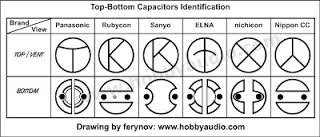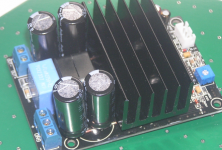Yes the chinese tristar vent Nichicons on your ampboards are the real thing, all japanese cross vent Nichicons are fake, and your testboard is absolutely safe.
Thanks for confirming that these are real Nichicons.
As irribeo has rather dryly pointed out, your caps don't look the same as mine.
I thought the build quality and components appear to look good. What are other suggested values for setting gain and input impedance ? If I want to be able to drive them with the usual RCA line level outputs of a miniDSP, can I leave it alone?
Having studied another reference design of IR's, I think (no guarantees mind) that this amp is an incarnation of the IRAUDAMP7 reference design. At least the 120k and 3k + 330R resistors match up with the schematic and there are various protection circuits under the heatsink which at first glance look similar to those in this design. Full technical blurb is here : http://www.irf.com/technical-info/refdesigns/iraudamp7d.pdf
As irribeo has rather dryly pointed out, your caps don't look the same as mine.
Having studied another reference design of IR's, I think (no guarantees mind) that this amp is an incarnation of the IRAUDAMP7 reference design. At least the 120k and 3k + 330R resistors match up with the schematic and there are various protection circuits under the heatsink which at first glance look similar to those in this design. Full technical blurb is here : http://www.irf.com/technical-info/refdesigns/iraudamp7d.pdf
So yours came with real Nichicons and mine with fake? Is it certain that 3-star vent is fake? Why would they bother to put real Nichicons on some and not others? If you are going to make fakes why not go all out and save as much as possible?
Searching for IRS2092 on Taobao reveals that there's more than one vendor with what looks to be the same PCB, but different BOM. For example there's this one where they're using a toroidal output choke - can't see any difference in the PCB but of course I've not done a thorough examination. Is it possible some eBay vendors cut costs to make the international prices as low as ones within China? This one also has the 3-score topvents like yours.
Attachments
Yes the chinese tristar vent Nichicons on your ampboards are the real thing, all japanese cross vent Nichicons are fake, and your testboard is absolutely safe.
Weeks ago we were talking about some ESR/ESL measurements of those fake/real Nicho/Oscon/whatsoever. Did you showed any values yet, i haven't found any. (Maybe missed)
🙂
View attachment 489791 Hope this helps
Original source:
http://hobbyaudios.blogspot.de/2011/04/identify-good-original-capacitors.html
But this is not fail-proof, as manufacturers use more than just this shapes to make their caps.
I.e., see this Panasonic datasheet. The bottom cap is done differently for caps <=8mm and >8<=10.
Last edited:
Black GSK 2200uF on my "smakn" were around 40mOhm, not bad, UCC KZM 2200uF same meter 10mOhm, Oscon 330uF double the KZM half the GSK 🙂 frequency 4000hz I believe
I don't think they are really different than KZE, KZH, KZN, maybe in lifespan. I don't have KZM on my 2092's, those pcb's came with Frolyt and haven't tried others.
XRK971,
Have a look into the datasheets to see the differencies. Are there any special demands in this particual circuit that require an exactly cap series (KZM, KZE, etc.)?
irribeo,
Frolyt caps are from Germany (formerly East Germany), i'd never ever seen those caps in any chinese product for the last 20 years.
Could you post a picture of the minus sign printed on the cap?
Have a look into the datasheets to see the differencies. Are there any special demands in this particual circuit that require an exactly cap series (KZM, KZE, etc.)?
irribeo,
Frolyt caps are from Germany (formerly East Germany), i'd never ever seen those caps in any chinese product for the last 20 years.
Could you post a picture of the minus sign printed on the cap?
Last edited:
My 2092's are German 🙂
http://www.frolyt.de/ERY.pdf
Normally Elna RJJ, but my PSU voltage was little high for those and 100V RJJ too big to fit I believe.
http://www.frolyt.de/ERY.pdf
Normally Elna RJJ, but my PSU voltage was little high for those and 100V RJJ too big to fit I believe.
Last edited:
Have a look into the datasheets to see the differencies. Are there any special demands in this particual circuit that require an exactly cap series (KZM, KZE, etc.)?
I was thinking from the standpoint of the 3116, whether or not it would improve the performance even further than the OSCON's which I can hear the difference. I do not know enough about the the 2092 to say one way or the other about what cap would work better. But if class D amps all work be using a PWM switch mode, then would having the lowest ESR be best? The lower the better?
I am looking forward to connecting the 2092's to my reference monitors to see if I can hear any improved clarity, SNR, or dynamics. They seem like a really clean sounding amp from what I can hear so far. Their down fall is probably the dual rail HV requirement vs the simple 19v SMPS brick that make the 3116 or 3482/98 so popular.
Last edited:
The lower the better is always best, but the question is, how much capacitance is sufficient. If you have unlimited space, money, you can have unlimited capacitance. 😀
There will be an economical/pcb-space limit.. I mean, you can have 24V+-200mVripple or i.e. 24V+-1mV ripple. The question here is, how much voltage-ripple do you allow and will this be audible at the application.
This depends on your speakers, ears, room, music-content, switching-frequency, crest-factor etc. (or load-profile)
Beside this, there is a limit in capacitance for SMPS regarding inrush-current and regulation-time. While more capacitance makes your rail stiffer, the smps regulation will get slower and slower. Some even fail to start because of to much capacitance and so their time-constant.
To round up, the capacitance needed can be calculated.
There will be an economical/pcb-space limit.. I mean, you can have 24V+-200mVripple or i.e. 24V+-1mV ripple. The question here is, how much voltage-ripple do you allow and will this be audible at the application.
This depends on your speakers, ears, room, music-content, switching-frequency, crest-factor etc. (or load-profile)
Beside this, there is a limit in capacitance for SMPS regarding inrush-current and regulation-time. While more capacitance makes your rail stiffer, the smps regulation will get slower and slower. Some even fail to start because of to much capacitance and so their time-constant.
To round up, the capacitance needed can be calculated.
Many amplifier types the input impedance can be accurately determined by measuring the input to ground with an ohm meter. Simply reporting what I measured for those who maybe interested.
doctormord is correct for those reasons and more. like not causing loop feedback instability.
For SMPS there is an optimum load capacitance, with out knowing or measuring anything I would NOT use more than 50% of total of the capacitance seen on each SMPS rail esp if they are V regulated. ( even if the output isn't regulated you cause more ripple to go off board) bigger is not always better. power decoupling off board consider using common mode chokes, to minimize noise and interaction between common supplies and/ or amps. take into account SMPS topology, grounding, and noise reduction targets. "off board" = away from SMPS outputs
common mode chokes can be simply constructed by winding or looping twisted pairs around a 25mm ferrite toroid core. useful fixes in many problem scenarios. good hookup wire recommend for fitting a decent amount of copper inside there.
For SMPS there is an optimum load capacitance, with out knowing or measuring anything I would NOT use more than 50% of total of the capacitance seen on each SMPS rail esp if they are V regulated. ( even if the output isn't regulated you cause more ripple to go off board) bigger is not always better. power decoupling off board consider using common mode chokes, to minimize noise and interaction between common supplies and/ or amps. take into account SMPS topology, grounding, and noise reduction targets. "off board" = away from SMPS outputs
common mode chokes can be simply constructed by winding or looping twisted pairs around a 25mm ferrite toroid core. useful fixes in many problem scenarios. good hookup wire recommend for fitting a decent amount of copper inside there.
Last edited:
Are you saying the hot ticket is the KZM? Can those be ordered via Digikey?
Assuming you're buying from Digikey, I'd say these are your best bet as replacements for the originals.
EKYB800ELL471MK30S United Chemi-Con | 565-3994-ND | DigiKey
Seeing as they're 12.5mm diam you can (just) fit two in place of the wider originals if you solder some thick copper wire onto the pads to act as 'busbars'. Here's mine with 12.5mm*30mm Rubycon ZLHs.
Attachments
when the esr goes into the 10's mohms the trace layout becomes the limiting factor, adding "bus bars" on top usually makes the routing worse. Ived used 4 leaded caps in these kind of apps. study the PCB routing its probably not that good
Last edited:
Assuming you're buying from Digikey, I'd say these are your best bet as replacements for the originals.
EKYB800ELL471MK30S United Chemi-Con | 565-3994-ND | DigiKey
Seeing as they're 12.5mm diam you can (just) fit two in place of the wider originals if you solder some thick copper wire onto the pads to act as 'busbars'. Here's mine with 12.5mm*30mm Rubycon ZLHs.
Thanks for the Digikey tip...
I am going to leave my stock caps in place for now. They sound decent enough thus far. Hope they don't explode...
Just keep an eye on that '3 prong' vent if you're running anywhere near the rated voltage of the caps (which you probably won't since 100V rails will fry the output MOSFET first). Probably staying well away from 100V you'll be fine. All the 'fakes' I've had worked OK well below their marked voltage.
- Home
- Amplifiers
- Class D
- 200W IRS2092 Amp for $20


